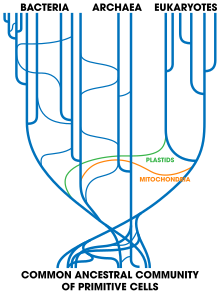基因水平轉移
| 此條目需要擴充。 (2014年2月9日) |
| 此條目需要精通或熟悉相關主題的編者參與及協助編輯。 |


基因水平轉移(英語:horizontal gene transfer,縮寫:HGT)又稱水平基因轉殖、"橫向轉基因"或基因側向轉移(lateral gene transfer,縮寫:LGT),指生物個體之間互相遺傳物質而通過生殖將其傳給子代的過程。基因水平轉移對於細菌的進化至關重要,但高等生物也會發生基因水平轉移[2][3]。
在細菌之中,基因水平轉移的常見途徑包括接合、轉導及轉化[4]。質粒與溫和噬菌體是常見的細菌基因水平轉移的載體[5][6]。例如,在細菌獲得抗生素抗藥性過程中,抗藥性基因可通過基因水平轉移迅速在細菌之間傳播,最終使整個菌群快速獲得對抗生素的抗藥性[7][8][9][10]。
歷史[編輯]
生物學史上的經典實驗之一的格里菲斯實驗中,無毒性的R型肺炎鏈球菌與高溫殺滅的有毒性的S型肺炎鏈球菌混合後注射入小鼠體內,R型肺炎鏈球菌會轉化成有毒性的S型肺炎鏈球菌將小鼠殺死。只是當時的人們尚不清楚這一現象是由基因水平轉移造成的,也不知道這一現象背後的機制就是R型肺炎鏈球菌攝取了S型肺炎鏈球菌的質粒進而轉變成了S型肺炎鏈球菌[11][12]。
直到1951年,科學家才第一次真正發現基因水平轉移現象。當時,困擾醫學界的一個問題是,許多白喉患者很早就感染了病原體白喉棒桿菌但並不發病,而是在某一個時間節點後才突然發病。在對這一現象的研究過程中, 巴斯德研究所的安德列·利沃夫團隊發現這背後的原理是一個病毒基因轉入白喉棒桿菌後,弱毒性的白喉棒桿菌菌株會轉變成強毒性的菌株,因此使病人突然患上白喉[13]。安德列·利沃夫後來因為這項工作獲得了1965年的諾貝爾生理醫學獎[14]。1959年,科學家從不同物種的細菌之間傳遞抗生素抗藥性的過程中發現了細菌與細菌之間的基因水平轉移[15][16] 。
基因水平轉移生物[編輯]
參考文獻[編輯]
- ^ Sidney K. Pierce, Xiaodong Fang, Julie A. Schwartz, Xuanting Jiang, Wei Zhao, Nicholas E. Curtis, Kevin M. Kocot, Bicheng Yang, Jian Wang. Transcriptomic Evidence for the Expression of Horizontally Transferred Algal Nuclear Genes in the Photosynthetic Sea Slug, Elysia chlorotica. Molecular Biology and Evolution. 2012-06-01, 29 (6): 1545–1556 [2018-04-02]. ISSN 0737-4038. doi:10.1093/molbev/msr316. (原始內容存檔於2018-06-01) (英語).
- ^ Gyles C, Boerlin P. Horizontally transferred genetic elements and their role in pathogenesis of bacterial disease. Veterinary Pathology. March 2014, 51 (2): 328–40. PMID 24318976. S2CID 206510894. doi:10.1177/0300985813511131.
- ^ Vaux F, Trewick SA, Morgan-Richards M. Speciation through the looking-glass. Biological Journal of the Linnean Society. 2017, 120 (2): 480–488. doi:10.1111/bij.12872
 .
.
- ^ Horizontal and vertical: The evolution of evolution - life - 26 January 2010 - New Scientist. [2010-01-29]. (原始內容存檔於2015-04-02).
- ^ Naik GA, Bhat LN, Chpoade BA, Lynch JM. Transfer of broad-host-range antibiotic resistance plasmids in soil microcosms. Curr. Microbiol. 1994, 28 (4): 209–215. doi:10.1007/BF01575963.
- ^ Varga M, Kuntova L, Pantucek R, Maslanova I, Ruzickova V, Doskar J. Efficient transfer of antibiotic resistance plasmids by transduction within methicillin-resistant Staphylococcus aureus USA300 clone. FEMS Microbiol. Lett. 2012, 332 (2): 146–152. PMID 22553940. doi:10.1111/j.1574-6968.2012.02589.x.
- ^ OECD, Safety Assessment of Transgenic Organisms, Volume 4: OECD Consensus Documents, 2010, pp.171-174
- ^ Kay E, Vogel TM, Bertolla F, Nalin R, Simonet P. In situ transfer of antibiotic resistance genes from transgenic (transplastomic) tobacco plants to bacteria. Appl. Environ. Microbiol. July 2002, 68 (7): 3345–51 [2014-02-09]. PMC 126776
 . PMID 12089013. (原始內容存檔於2020-06-05).
. PMID 12089013. (原始內容存檔於2020-06-05).
- ^ Koonin EV, Makarova KS, Aravind L. Horizontal gene transfer in prokaryotes: quantification and classification. Annu. Rev. Microbiol. 2001, 55: 709–742 [2014-02-09]. PMID 11544372. doi:10.1146/annurev.micro.55.1.709. (原始內容存檔於2019-09-19).
- ^ Nielsen KM. Barriers to horizontal gene transfer by natural transformation in soil bacteria. APMIS Suppl. 1998, 84: 77–84. PMID 9850687.
- ^ Lorenz MG, Wackernagel W. Bacterial gene transfer by natural genetic transformation in the environment. Microbiological Reviews. September 1994, 58 (3): 563–602. PMC 372978
 . PMID 7968924. doi:10.1128/MMBR.58.3.563-602.1994.
. PMID 7968924. doi:10.1128/MMBR.58.3.563-602.1994.
- ^ Downie AW. Pneumococcal transformation--a backward view. Fourth Griffith Memorial Lecture (PDF). Journal of General Microbiology. November 1972, 73 (1): 1–11 [2023-08-10]. PMID 4143929. doi:10.1099/00221287-73-1-1
 . (原始內容存檔 (PDF)於2012-03-02).
. (原始內容存檔 (PDF)於2012-03-02).
- ^ Freeman VJ. Studies on the virulence of bacteriophage-infected strains of Corynebacterium diphtheriae. Journal of Bacteriology. June 1951, 61 (6): 675–88. PMC 386063
 . PMID 14850426. doi:10.1128/JB.61.6.675-688.1951.
. PMID 14850426. doi:10.1128/JB.61.6.675-688.1951.
- ^ André Lwoff (1965). "Interaction among Virus, Cell, and Organism" (頁面存檔備份,存於互聯網檔案館). Nobel Lecture for the Nobel Prize in Physiology or Medicine.
- ^ Ochiai K, Yamanaka T, Kimura K, Sawada O. Inheritance of drug resistance (and its transfer) between Shigella strains and Between Shigella and E. coli strains. Hihon Iji Shimpor. 1959, 1861: 34 (日語).
- ^ Akiba T, Koyama K, Ishiki Y, Kimura S, Fukushima T. On the mechanism of the development of multiple-drug-resistant clones of Shigella. Japanese Journal of Microbiology. April 1960, 4 (2): 219–27. PMID 13681921. doi:10.1111/j.1348-0421.1960.tb00170.x
 .
.
- ^ 整個世界都是我的裝備庫!來看看地表最強的水熊秘訣. PanSci 泛科學. 2015-12-02 [2017-03-09]. (原始內容存檔於2017-03-25) (中文(臺灣)).
參見[編輯]
| ||||||||||||||||||||||
